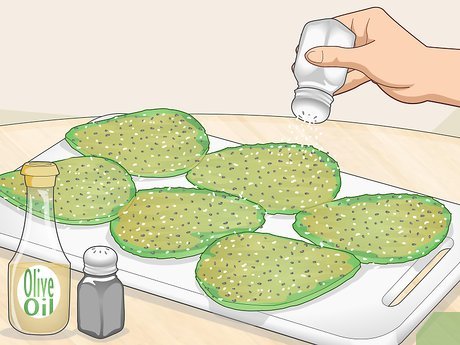Cactus, often associated with arid landscapes and unique ecosystems, has become an impressive culinary ingredient. Particularly the pads of the prickly pear cactus (Opuntia), also known as “nopales,” offer a range of flavors and textures that can enhance various dishes. Not only are they versatile, but they are also packed with nutrients, providing an excellent source of vitamins C and K, fiber, and antioxidants. This article explores a variety of methods to prepare and cook cactus, ensuring you can integrate this fascinating ingredient into your culinary repertoire.
Before delving into cooking techniques, it is imperative to understand the selection and preparation of cactus. The quality of the cactus can significantly influence the outcome of the dish.
Choosing Fresh Cactus: What to Look For
When selecting cactus pads, aim for firm, vibrant green pads. Steer clear of any that appear overly wrinkled, discolored, or dried out. Fresh nopales should have a slimy texture when cut, which diminishes considerably upon cooking. If you opt for a prickly pear cactus, the fruit—known as tunas—can also be utilized in various recipes, from sweet to tangy.
Preparing Cactus: A Step-by-Step Guide
Preparation involves a few critical steps. First, carefully wash the cactus pads under running water to remove any dirt and debris. Next, using a sharp knife, cut off the edges of the pads to remove any spines and thorns. It is prudent to wear gloves during this step to avoid any pricks. After trimming, slice the pads into strips or small cubes, depending on your recipe’s requirements.
Once your cactus is prepped, it can be cooked through various methods, each bringing out distinct flavors and textures.
Grilling Cactus: Smoky, Charred Perfection
Grilling is a popular method that infuses cactus with a delightful smoky flavor. To grill cactus pads, preheat your grill to medium-high heat. Toss the sliced pads in olive oil, and sprinkle with salt and pepper for flavor. Grill each side for approximately three to five minutes or until you see an appealing char and the pads become tender. The result is a delectable side dish that can serve as a vegetable accompaniment or a base for salads. Adding fresh herbs or balsamic glaze post-grilling can elevate the flavors.
Sautéing Cactus: Quick and Flavorful
Sautéing cactus allows for quick preparation and versatile ingredient combinations. In a hot pan, heat olive oil or butter. Add onions, garlic, or other aromatics of your choice for a flavorful base. Once these ingredients are softened, add your chopped cactus. Cook for about five to seven minutes, stirring frequently until the cactus has lost its slime and is tender. Season with salt, pepper, or spices like cumin and chili powder for an added kick. This method is ideal for creating a vibrant stir-fry or wrapping in tortillas for tacos.
Steaming Cactus: Retaining Nutrients and Flavor
Steaming is another method that preserves the nutrients found in cactus pads while providing a soft texture. Fill a pot with a little water, bring it to a boil, and place the cactus pads in a steaming basket above the water. Cover and steam for roughly six to eight minutes. The pads can then be used as a base for salads or blended into smoothies for a nutrient boost. Serve steamed cactus with a sprinkle of lime juice or a drizzle of olive oil to enhance its natural flavor.
Incorporating Cactus into Dishes: A Culinary Adventure
The versatility of cooked cactus allows it to be included in various dishes. Consider adding grilled or sautéed cactus to salads for an interesting crunch, or mixing it into scrambled eggs for breakfast. Cactus also pairs beautifully with beans and corn in Mexican-inspired dishes, such as quesadillas or burritos. Another innovative approach includes crafting cactus salsa by combining diced cactus with tomatoes, onions, jalapeños, and cilantro — a refreshing twist on traditional salsa.
Utilizing Prickly Pear Fruit: Sweet and Tangy Delicacies
Beyond the pads, the fruit of the prickly pear cactus, known as tunas, is equally magnificent. This vibrant fruit can be cooked down into jellies or used in smoothies, sauces, and desserts. To prepare the fruit, remove the spines and peel away the skin, revealing the juicy, sweet flesh. Blend it into a smoothie with citrus or use it to add natural sweetness to sauces or dressings. Its unique flavor lends itself wonderfully to both sweet and savory dishes.
Health Benefits of Cactus: A Nutrient Powerhouse
In addition to its culinary allure, the health benefits of cactus deserve attention. Its high fiber content aids digestion, while antioxidants help combat oxidative stress in the body. The presence of anti-inflammatory properties is also noteworthy, making cactus a great addition to a balanced diet. Consequently, cooking cactus not only introduces new flavors to your meals but also enhances overall nutrition.
Conclusion: Exploring the World of Cactus Cooking
In summary, cooking cactus is more than just a novelty; it is an exploration of flavors, traditions, and health benefits. By utilizing various cooking methods—grilling, sautéing, and steaming—one can easily incorporate cactus into an array of dishes. Whether you are looking to introduce nutritious ingredients into your meals or experiment with culinary applications, cooking cactus can offer rewarding experiences both in the kitchen and at the dining table. With its vibrant flavors and nutritional perks, cactus is poised to become a staple in contemporary cooking.





Leave a Comment